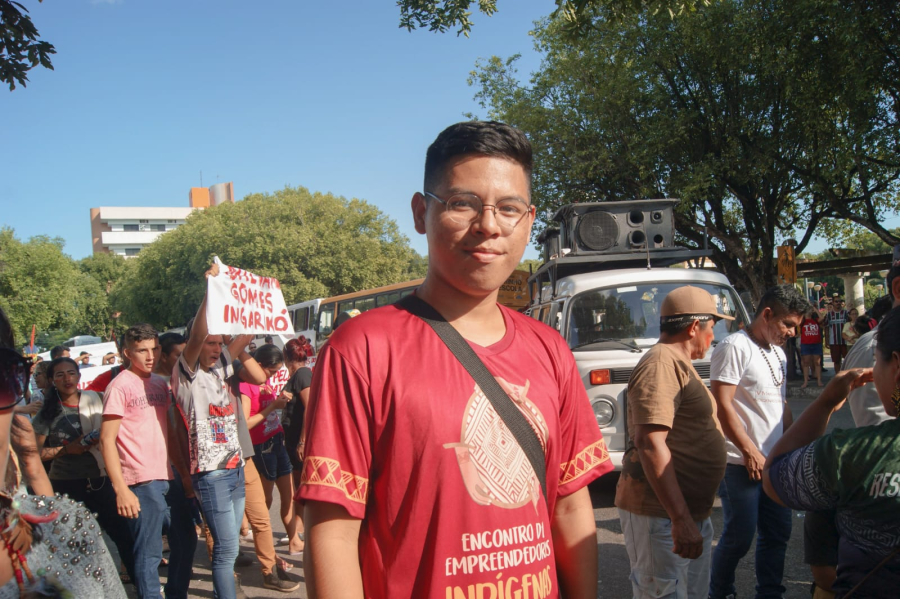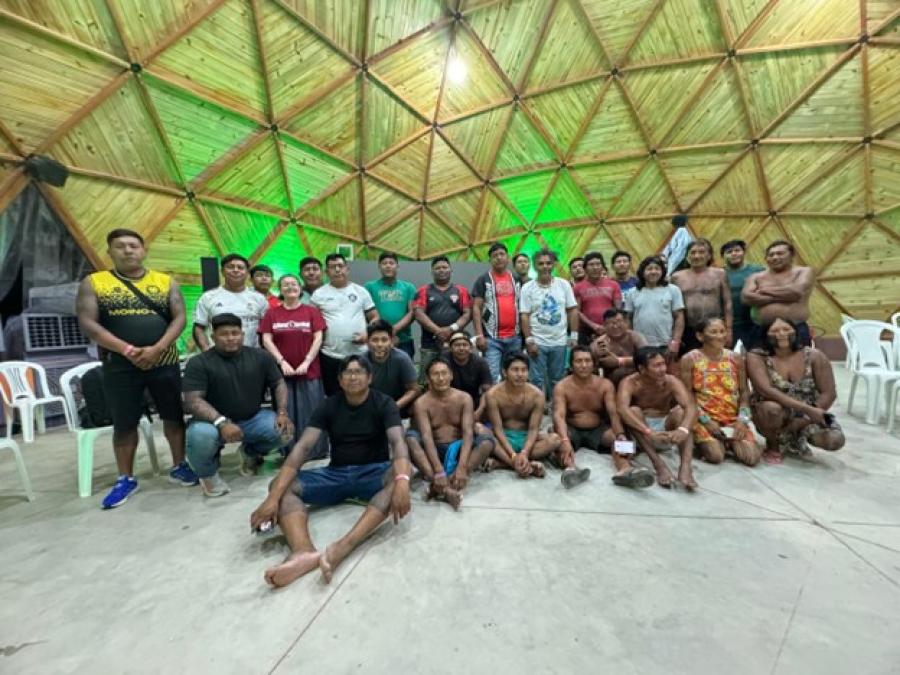Tropical flora shrouded the paths to an aboriginal hut in which lay an array of baskets and native utensils. Several small dug-out canoes, paddles, fishing nets, and spears were scattered about the earthen clearing around the thatch-roofed dwelling. Intermittent cries of tucans and papagallos mixed with the buzz of computerized cash registers in Macy's San Francisco furniture department.
The Amazon Exhibit had been advertised as "another first for Macy's. A cultural event in its own right and an unprecedented opportunity to invest in collectable ethnic art from South America." Why invest in art from the Amazon? "Compared to the, cost of ethnic art from North American Indians and that of Africa and New Guinea", the sponsors of this exhibit considered "every item in...(their) collection a singular value." With prices ranging from $25.00 to $5,000.00, the art in this collection was billed as a "unique investment opportunity because of its rarity, the difficulty in obtaining it and the fact that some of the tribal traditions are unfortunately destined toward extinction." The advertisement stated that, "in a sense it is an investment which preserves the culture of the Amazon." The public was invited to visit "The Amazon" from January 22 through March 25, 1982.
This exhibition and sale of ethnographic artifacts from the Brazilian, Peruvian, and Colombian Amazon was designed by Macy's California to attract customers to the store. Macy's obtained objects through missionaries who collected items by request. Indians were paid prices negotiated by missionaries, or by Macy's representative during his short visit to the region. The result was an "impressive accumulation of over one thousand weapons, tools, ceremonial masks and objects" from the Kamaiura, Yawalapiti, Txukahamae, Kayapo, Mayongong, Waika of Brazil; the Maku of Colombia and Brazil, the Tucano of the Rio Negro, and the Ticuna and Yaguas of Solimoes; the Shipibo of Peru. Articles for sale included ceramic pots from $50.00 to $400.00, wooden dolls for $950.00, canoes costing $300.00 to $700.00, wooden stools for $60.00 to $600.00, ceremonial costumes for $1,500.00, plus many other objects too numerous to mention.
Why did Macy's decide on the Amazon? The exhibit brochure explained that "statistics alone do not reflect the exotic and diverse jungle environment, the myriad species of plant and animal life or the various Indian cultures which inhabit the Amazon. It must be visited to be believed." Three of Macy's "more adventurous buyers" took a five-week journey and returned with ethnic art from the Amazon. "Some of the crafts had been passed down from generation to generation reaching back to pre-Columbian times...These items were made for personal use, not commercial export." The exhibit brochure states that this collection, the first of its kind, reflects a lifestyle...a culture...an environment...A buying trip of this sort...was unprecedented. Few had ever explored the area for collectible ethnic art, and no one had attempted to accumulate and move as many pieces as Macy's planned to do.
What of the physical environment and the conditions under which this unprecedented journey was conducted? One learns from the brochure that timing was a key factor. The travelers wanted to arrive after certain ceremonial rites...(because) special masks, costumes and religious pieces were created only for these occasions then discarded afterwards...Another crucial consideration was the weather. The trip had to be timed just after the rainy season to insure safe travel in a small bush plane before shallow water made landings impossible.
Other "risks" were "pesty to poisonous insects and snakes, piranha-infested waters dotted with colonies of crocodiles, unbearable heat and humidity and virtual isolation from the rest of the world." To get to "the distant villages, the team of three plus a pilot and interpreter flew across acres and acres of thick, impenetrable jungle...were picked up by boat...and taken down the narrower tributaries", and finally transferred "to a smaller boat (which) took them the last few miles through the narrowest channels to the Indian villages hidden in the thick recesses of the jungle."
One must not forget the human elements of this journey, the indigenous people. The brochure tells the reader that there are twenty-three [sic] known Amazon Indian cultures - each one as diverse as the environment itself. But what was common to all was the warmth and excitement that greeted the crew when they arrived at the river banks. Radio communication was made to the local missionaries so each tribe would understand when 'the people from the sky' would be arriving.
An anthropologist from Santa Rosa Junior College demonstrated Amazonian cultural diversity through slides and discussion. The middle class audience was told about happy natives who live in harmony with their natural environment. Slides showed smiling Indians. The presentation was in the spirit of a tourist travel show, and the audience was satisfied with its vicarious trip to the jungle. No one left the slide show knowing about the struggles in which most Amazonian Indians are engaged. Land rights and exploitation of resources by multinationals were not mentioned. Native artifacts are more saleable if they come from an idyllic paradise then if they come from hungry, angry or exploited Indians.
The anthropologist considered the exhibit a first step in public appreciation for Amazonian ethnic art. He stated that once the public realized the value of Amazon art they might then begin to appreciate the people and cultures. He hoped that Macy's success with the exhibit would encourage the company to continue to collect and sell Amazonian artifacts which would produce long-term benefits for native populations. The sale of native art could be one way for Indians to obtain an economic base which would permit their integration into national economies on their terms. He considered that this might be the best way to save native cultures, citing the Navajo and Pueblo as examples of successful development of Indian craft industries.
However, solutions to the real problems encountered by native peoples of the Amazon are not so easily found:
Outside intervention in the area of craft production can cause irreparable damage to indigenous ways of life, deteriorating social organization, and effecting self-image and ethnic identity. In other words, we must check to see at which point craft production for the market can alter the principle social institutions which bring order to indigenous life, as well as the ecosystem of which the native is a part.
An interview with the exhibit coordinator, uncovered another point of view. He stated that in a village a basket could be purchased for fifty cents, when the same item was purchased from a cooperative store in Brasilia or Peru, it cost $15.00. This man said that Indians did not appear to care about the prices of their artifacts. Transporting the objects cost more than the artifacts themselves. Special packing materials were flown to interior sites where the items were packed for shipment.
When discussing missionary efforts with native peoples, the coordinator stated that the cultural transformation of indigenous groups appeared to be the only alternative to extinction. He considered that intrusion of multinationals into the Amazon made traditional native life impossible, and the Indians were unable to adjust to a different kind of life, since they were not successful in obtaining work in towns, and many went into crime. It seemed to him that if these people were at the bottom of the evolutionary scale, it would be best to leave them alone. In spite of the fact that the Amazonian native population is considered low on the evolutionary scale to the exhibit coordinator, their artifacts were useful as bait to attract customers to the furniture department. Perhaps the exhibit made no profit - the exhibit cost $1,000,000 - one-million dollars, and Macy's expected to recoup only $400,000 - but one must not forget the profits earned on furniture sales which resulted from the exhibit, nor the future sales such publicity would generate.
Many of the one-thousand objects exhibited, such as Shipibo ceramics and Rio Negro baskets, were produced for the tourist market. These items are not considered "art" by the producers. They become "art" only after they are labelled as such by consumers in a foreign market. While European colonization created a market for African and Oceanic "primitive art" long ago, the remaining Amazonian Indian groups have only recently been exploited as producers of "art." Although many artifacts may not be considered fine art by Western standards, their exotic origin makes them valuable.
When items produced for personal use become "art," a process which might be considered the folklorization of culture has begun. Folklorization of culture refers to a two-sided phenomenon. First, aspects of traditional culture are stereotyped for export. Second, these stereotyped features are internalized by members of the culture in question as markers of their own identity.
When indigenous peoples depend entirely upon the commodification of their own culture for export, the process is intensified.
Article copyright Cultural Survival, Inc.



